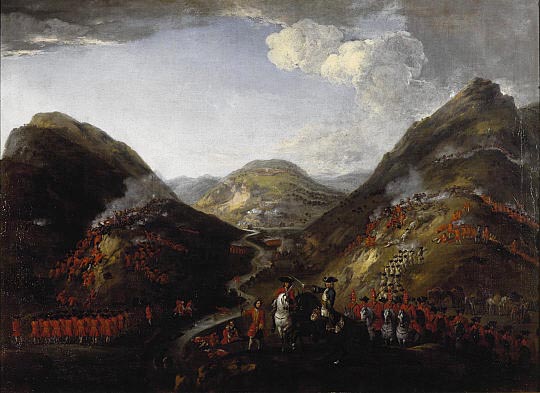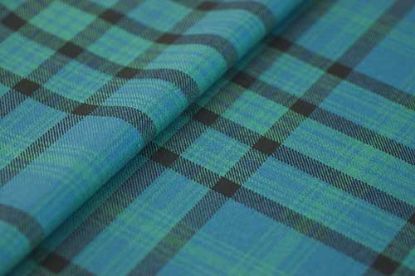Following the death of James VII & I in 1701, the claim to the British throne was taken up by his son, Prince James Francis Edward Stuart, who became known as “The Old Pretender”. With the death of Queen Anne in 1701, and the British throne passing to the Elector of Hanover, who became George I, there was widespread disaffection. The Old Pretender had been in correspondence for several years with John Erskine, 22nd Earl of Mar and, in 1715, with the unpopularity of the Hanovarian Government in the ascendancy, called upon him to raise the Highland clans. By September, Mar had raised 8,000 men.
9th-14th November 1715 Battle of Preston
A Jacobite army under Brigadier William Mackintosh of Borlum crossed the Firth of Forth and marched south to join up with a force raised in Northumberland. The Highlanders were reluctant to cross the Border, but were reassurance that they would be welcomed. This was not the case and finding themselves surrounded by the Hanovarian army at Preston, they surrendered.
13th November 1715 Battle of Sheriffmuir
The Jacobite army led by the Earl of Mar was attacked near Dunblane by the Government army led by John Campbell, 2nd Duke of Argyll. Although Argyll's forces withdrew, both sides claimed victory. The following month, The Old Pretender landed at Peterhead, but finding enthusiasm among his supporters at a very low ebb, returned to France.
 |
The Battle of Glenshiel, Peter Tillemans (1684 - 1734). Oil on canvas 1719 |
10th June 1719 Battle of Glenshiel
A force of Spaniards accompanied by William Mackenzie, 5th Earl of Seaforth, George Keith, 10th Earl Marischal, and the Marquess of Tullibardine, son of the 1st Duke of Atholl, landed in Scotland to support the Jacobite Cause. They established themselves at Eilean Donan Castle where they were joined by Rob Roy Macgregor, Clan Macrae, Cameron of Locheil and Lord George Murray. When Eilean Donan came under fire from five Royal Navy ships and captured, however, it was found to have been largely abandoned. At nearby Glenshiel, the Government forces confronted the Spaniards and the Jacobites, but when the support that the Jacobites had been promised from the Lowland Scotland failed to arrive, they scattered.
His father having appointed him Prince Regent, Prince Charles Edward Stuart, “The Young Pretender”, raised the Jacobite standard at Glenfinnan on the Scottish mainland to rally the Highland Clans. With men from Clan Donald and Clan Cameron, he marched on Edinburgh and took up residence at the Palace of Holyroodhouse.
21st September 1745 Battle of Prestonpans (also known as Battle of Tranent or Battle of Gladsmuir).
With news of the Jacobite occupation of Edinburgh, Sir John Cope, Commander of the Government army in Scotland, rallied his soldiers at Dunbar and marched north towards the Capital. The two armies met at Tranent and, as dawn broke, Cope's dragoons were destroyed by a Highland charge. It took only ten minutes for the Government army to be totally overwhelmed.
23rd December 1745 Battle of Inverurie
With the intention of putting a stop to Jacobite recruitment, John Campbell, 4th Earl of Loudon, Hanovarian Commander-in-Chief in the Highlands, sent a force of MacLeods, Grants and Munros to confront Lord Lewis Gordon and his Jacobites at Aberdeen. Finding themselves greatly outnumbered, they were driven them back into their own territory.
17th January 1746 Battle of Falkirk Muir
Having retreated from Derby, the Jacobite army reached Glasgow in January 1746, and moved on to lay siege to Stirling Castle. Meanwhile, the English Commander Lieutenant General Henry Hawley had brought his army from Newcastle to Edinburgh and came face-to-face with the Jacobites at Falkirk. The Government troops were massacred, but the Jacobites failed to press home their advantage. Hawley was soon able to re-group his army in Edinburgh.
15th April 1746 Battle of Littleferry (sometimes known as Battle of Bonnar Bridge)
Soldiers sent by the 3rd Earl of Cromartie, a Jacobite supporter, had attacked Dunrobin Castle, forcing the 17th Earl of Sutherland to flee. The Jacobites assumed they had won the day but, on marching off, were attacked and taken prisoner by the Sutherland men.
16th April 1746 Battle of Culloden
The last battle to be fought on British soil, the Battle of Culloden brought to an end not only the 1745 Jacobite Rising, but the old Highland way of life.
In January 1746, Prince William, Duke of Cumberland, younger son of George II, arrived in Scotland in January 1746 to take command of the Government army. In the meantime, his cousin, Prince Charles Edward Stuart, had based his Jacobite army near Nairn, close to Inverness. The battle was fought on bleak moorland in driving rain, contrary to the advice of Lord George Murray who rightly insisted that the marshy ground made the traditional Highland Charge extremely difficult.
In the event, the Jacobite army was routed. Afterwards, Jacobite supporters throughout the north of Scotland were ruthlessly hunted down and slaughtered. Prince Charles Edward Stuart, however, escaped, and spent the following five months as a fugitive before taking ship to France from Borrodale on the Island of Skye.
























